Digital Poster
Hyperpolarization
Joint Annual Meeting ISMRM-ESMRMB & ISMRT 31st Annual Meeting • 07-12 May 2022 • London, UK

| Computer # | ||||
|---|---|---|---|---|
1062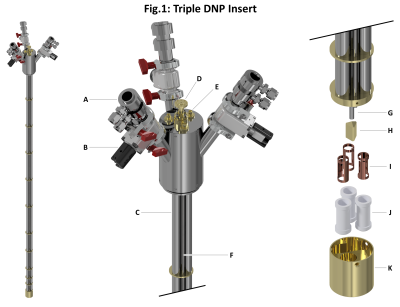 |
69 | Triple Multinuclear Probe: Expanding the Throughput and Versatility of a dDNP Polarizer
Thanh Phong Lê1,2, Emma Wiström2, Jean-Noël Hyacinthe1, and Andrea Capozzi2,3
1Geneva School of Health Sciences, HES-SO University of Applied Sciences and Arts Western Switzerland, Geneva, Switzerland, 2Laboratory of Functional and Metabolic Imaging, EPFL (Swiss Federal Institute of Technology in Lausanne), Lausanne, Switzerland, 3Department of Health Technology, Center for Hyperpolarization in Magnetic Resonance, Technical University of Denmark, Kgs Lyngby, Denmark
Low throughput is one of dDNP main shortcomings. Here, we present the design and performance of a triple DNP probe, which not only allows multiple samples to be hyperpolarized simultaneously, but also to distinctly monitor the solid-state polarization of each sample, even when prepared with different nuclei and radicals. This versatile high throughput probe allows parallel solid-state sample characterization, as well as sequential injections of distinct tracers to probe multiple biomarkers, thus enabling more advanced in-vivo experimental designs.
|
||
1063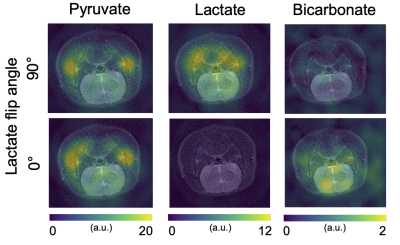 |
70 | Lactate excitation limits bicarbonate detection in hyperpolarized pyruvate MRI of the brain
Nikolaj Bøgh1, Camilla W Rasmussen1, Lotte B Bertelsen1, Esben SS Hansen1, and Christoffer Laustsen1
1Aarhus University, Aarhus, Denmark In hyperpolarized [1-13C]pyruvate MRI of the brain, pyruvate-to-bicarbonate conversion, representing oxidative metabolism, is detected at low levels, despite the highly oxidative metabolism of the brain. We sought to determine the effect of lactate excitation on bicarbonate detection in healthy rats imaged in a cross-over fashion (lactate flip angle = 90° or 0°). In the brain, the bicarbonate signal-to-noise ratio increased 65 % when lactate was not excited. This effect was not observed in the heart, kidneys or liver. Collectively, our data show that lactate saturation limits bicarbonate detection in the brain solely, which has implications for study designs. |
||
1064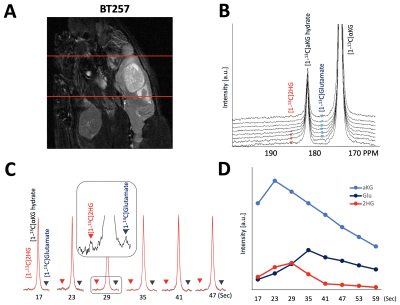 |
71 | Direct detection of 2HG and glutamate production using hyperpolarized [1-13C-5-12C]-a-ketoglutarate in cell and in vivo glioma models
Donghyun Hong1, Yaewon Kim1, Chandrasekhar Mushti2, Noriaki Minami1, Anne Marie Gillespie1, Pavithra Viswanath1, Rolf E. Swenson2, Daniel B. Vigneron 1, and Sabrina M. Ronen1
1University of California, San Francisco, San Francisco, CA, United States, 2NHLBI, Bethesda, MD, United States
Mutant IDH leads to 2HG production, which drives glioma development. 13C MRS monitoring of hyperpolarized [1-13C]α-ketoglutarate (αKG) metabolism to 2HG and glutamate provides a non-invasive assessment of the IDH mutation and normal metabolism, respectively. However, monitoring 2HG production in vivo is challenging because its resonance is within 0.1 ppm of the natural abundance [5-13C]αKG signal of the [1-13C]αKG substrate. Here, we utilized [1-13C-5-12C]αKG, which eliminated the [5-13C]αKG peak. This new approach, combined with an optimized sequence, made it possible to readily monitor the production of both 2HG and glutamate in a patient-derived glioma animal model and in normal brain.
|
||
1065 |
72 | Modelling the kinetics of cerebral lactate production after hyperpolarized [2H7, U-13C6]-D-glucose bolus
Emmanuelle Flatt1, Bernard Lanz1, Thanh Phong Lê1,2, Rolf Gruetter1, and Mor Mishkovsky1
1Laboratory for Functional and Metabolic Imaging (LIFMET), EPFL, Lausanne, Switzerland, 2Geneva School of Health Sciences, University of Applied Sciences and Arts Western Switzerland (HES-SO), Geneva, Switzerland
The present work describes a quantitative analysis of lactate 13C-labeling pattern following the metabolism of hyperpolarized [2H7,U-13C6]-D-glucose. This lactate production results from 12 biochemical steps including glucose transport, 10 enzymatic steps of glycolysis, and LDH mediated pyruvate-to-lactate conversion. The 3-compartment model description was found a good compromise to interpret the hyperpolarized metabolic curves. This demonstrates the potential of hyperpolarized [2H7, U-13C6]-D-glucose as a new biochemical probe for brain energy metabolism.
|
||
1066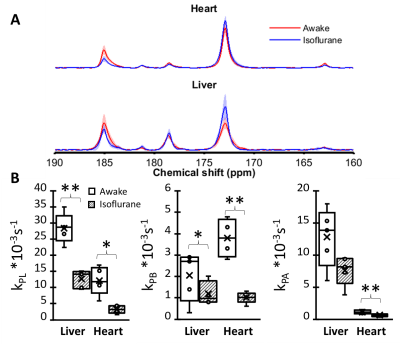 |
73 | Liver and heart metabolism of [1-13C]-pyruvate in awake and anesthetized rats
Viivi Hyppönen1, Jessica Rosa1, and Mikko Kettunen1
1A. I. Virtanen Institute, University of Eastern Finland, Kuopio, Finland
Anesthesia has profound effects on overall metabolism, leading to significant signal changes in metabolic MR brain experiments using hyperpolarized [1-13C]pyruvate. In the current study, we studied the possible origins of the signals from rat liver and heart under isoflurane anesthesia and while the animals were awake. Increased metabolite signals, especially lactate, were observed from both organs in awake animals.
|
||
1067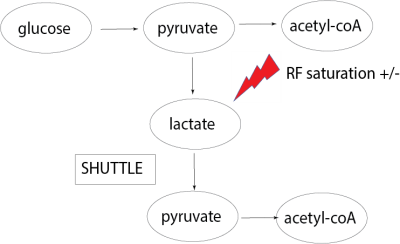 |
74 | Evidence of Lactate Shuttling in the Human Brain with Hyperpolarized 13C-MRI
Biranavan Uthayakumar1, Nadia Bragagnolo2, Hany Soliman3, Albert P Chen4, Ruby Endre5, William J Perks6, Nathan Ma6, Chris Heyn7, Sandra E Black8, and Charles H Cunningham5
1Medical Biophysics, University of Toronto, Mississauga, ON, Canada, 2Medical Biophysics, University of Toronto, Toronto, ON, Canada, 3Radiation oncolocy, Sunnybrook Health Sciences Centre, Toronto, ON, Canada, 4GE Healthcare, Toronto, ON, Canada, 5Physical Sciences, Sunnybrook Research Institute, Toronto, ON, Canada, 6Pharmacy, Sunnybrook Health Sciences Centre, Toronto, ON, Canada, 7Radiology, Sunnybrook Health Sciences Centre, Toronto, ON, Canada, 8Neurology and Hurvitz Brain Sciences Research Program Sciences, Sunnybrook Health Sciences Centre, Toronto, ON, Canada
It is well known that glucose is the primary source of energy in the brain, but mounting evidence suggests that at least some of this glucose is first converted to lactate and shuttled between cellular compartments before being oxidized in the TCA cycle. In this study, the hypothesis that this ”lactate shuttle” contributes to the 13C-lactate and 13C-bicarbonate signal observed in the awake human brain is tested using hyperpolarized 13C MRI (HP13C-MRI).
|
||
1068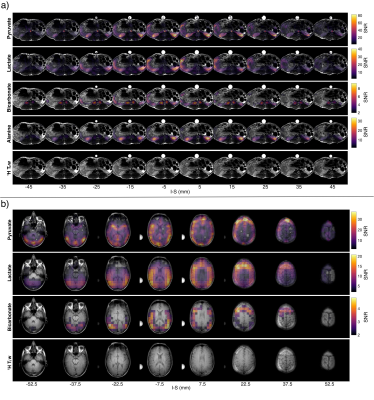 |
75 | Parallel imaging of hyperpolarized 13C MRI using 23Na sensitivity profiles
Rie Beck Olin1, Juan Diego Sánchez-Heredia1, James T Grist2,3,4,5, Wenjun Wang6, Nikolaj Bøgh7, Vitaliy Zhurbenko6, Esben S Hansen7, Rolf F Schulte8, Damian Tyler2,3, Christoffer Laustsen7, and Jan Henrik Ardenkjær-Larsen1
1Department of Health Technology, Technical University of Denmark, Kgs. Lyngby, Denmark, 2Department of Physiology, Anatomy and Genetics, University of Oxford, Oxford, United Kingdom, 3Oxford Centre for Clinical Magnetic Resonance Research, University of Oxford, Oxford, United Kingdom, 4Department of Radiology, Oxford University Hospitals Trust, Oxford, United Kingdom, 5Institute of Cancer and Genomic Sciences, University of Birmingham, Birmingham, United Kingdom, 6Department of Electrical Engineering, Technical University of Denmark, Kgs. Lyngby, Denmark, 7MR Research Centre, Department of Clinical Medicine, Aarhus University, Aarhus, Denmark, 8GE Healthcare, Munich, Germany Parallel imaging can aid hyperpolarized 13C MRI in extracting more information in the limited time window of the hyperpolarized signal. Using a dedicated, flexible 13C receive coil design with coupling coefficients matched for both 13C and 23Na, sensitivity profiles for reconstruction can be acquired at the 23Na frequency. We demonstrate this method in two hyperpolarized in vivo experiments involving pig kidneys and human brain using a two-times accelerated 3D blipped stack-of-spirals sequence with dual-resolution. The results show good SNR, coverage, and resolution. The method is promising for integrating and automating parallel imaging for hyperpolarized 13C MRI. |
||
1069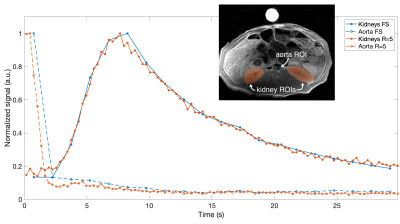 |
76 | Seiffert spirals for hyperpolarized 13C MRI with efficient k-space sampling and flexible acceleration
Rie Beck Olin1, Tobias Speidel2, Juan Diego Sánchez-Heredia1, Esben S Hansen3, Christoffer Laustsen3, Lars G Hanson1,4, Volker Rasche5, and Jan Henrik Ardenkjær-Larsen1
1Department of Health Technology, Technical University of Denmark, Kgs. Lyngby, Denmark, 2Core Facility Small Animal MRI, University of Ulm, Ulm, Germany, 3MR Research Centre, Department of Clinical Medicine, Aarhus University, Aarhus, Denmark, 4Danish Research Centre for Magnetic Resonance, Centre for Functional and Diagnostic Imaging and Research, Copenhagen University Hospital Hvidovre, Hvidovre, Denmark, 5Department of Internal Medicine II, University of Ulm, Ulm, Germany
The Seiffert spirals trajectory has favorable properties for hyperpolarized 13C MRI. It allows for high degrees of undersampling and combined conjugate gradient compressed sensing SENSE reconstruction when multi-channel arrays are used. The trajectory was evaluated in simulations, in phantom, and for in vivo hyperpolarized 13C-urea MRI of pig kidneys with retrospective undersampling and high temporal resolution. For single-frequency imaging, flexible acceleration is achieved through reconstruction based on any number and combination of spiral arms. Simulations demonstrated noise-like aliasing and successful reconstruction. The in vivo experiment showed improved characterization of urea dynamics after undersampling. The reconstruction algorithm can be further improved.
|
||
1070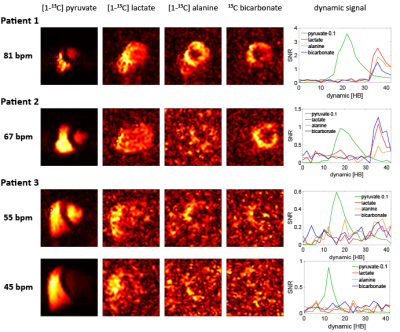 |
77 | On the impact of heart rate and relaxation on SNR of hyperpolarized 13C pyruvate metabolic imaging of the human heart
Julia Traechtler1, Maximilian Fuetterer1, Tobias Hoh1, Mohammed Albannay1, Andreas Dounas1, and Sebastian Kozerke1
1University and ETH Zurich, Zurich, Switzerland
In hyperpolarized 13C MRI, the achievable base SNR depends on the T1 relaxation of pyruvate in blood. Heart rate dependency on the resulting SNR is examined using simulations and exemplarily shown on human data of the heart. Measured T1 and T2 values at 1.5T and 3T of hyperpolarized 13C pyruvate in blood are reported. The results indicate that for a range of pyruvate concentrations, T2 remains >6s and hence T2* is primarily determined by field inhomogeneities. T1 is reduced at lower concentrations, and therefore heart rate plays a decisive role for the achievable SNR. Exemplary in-vivo data illustrate these findings.
|
||
1071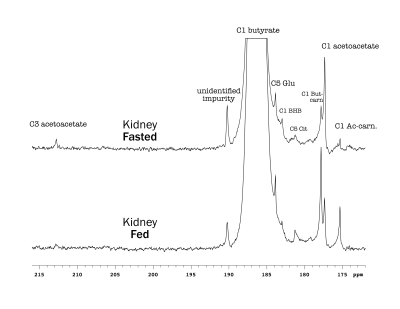 |
78 | Hepatic and renal ketogenesis of hyperpolarized (1-13C)butyrate: functional evidence of metabolic zonation
Hikari A. I. Yoshihara1, Rolf Gruetter1, and Verena Hoerr2,3
1LIFMET, EPFL, Lausanne, Switzerland, 2Medical Physics Group, Institute of Diagnostic and Interventional Radiology, Jena University Hospital, Friedrich Schiller University Jena, Jena, Germany, 3Heart Center, Department of Internal Medicine II, University Hospital Bonn, Bonn, Germany
Ketones bodies are an important metabolic fuel, and butyrate is a ketogenic short-chain fatty acid. We report the metabolism of hyperpolarized (1-13C)butyrate in the rat kidney and liver. The main metabolites in the kidney include [1-13C]acetoacetate, [1-13C]butyrylcarnitine and [5-13C]glutamate, and [1-13C]acetylcarnitine, 3-hydroxy[1-13C]butyrate, [5-13C]citrate and [3-13C]acetoacetate are also detectable. Fasting results in significantly lower butyrylcarnitine/[1-13C]acetoacetate and glutamate/[1-13C]acetoacetate ratios. Ketogenesis is observed in the liver and the [1-13C]butyrylcarnitine + [1-13C]acetoacetate signal normalized to butyrate is higher with fasting. The unexpectedly low 3-hydroxy[1-13C]butyrate signals are functional evidence of metabolic zonation, with acetoacetate production and reduction occurring in different cells.
|
||
1072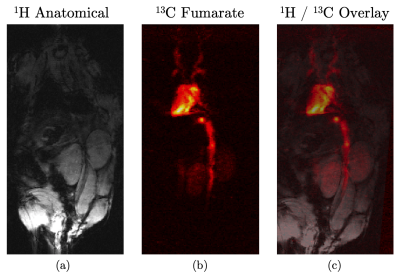 |
79 | In-vivo Imaging of hyperpolarized and purified Fumarate at 11.7 T
Tobias Speidel1, Stephan Knecht2, Martin Gierse2, Tobias Lobmeyer1, Gordon Winter3, Jessica Löffler3, Maximilian Fellermann4, Ilai Schwartz2, Holger Barth4, and Volker Rasche1
1Internal Medicine II, Ulm University Medical Center, Ulm, Germany, 2NVision Imaging Technologies GmbH, Ulm, Germany, 3Department of Nuclear Medicine, Ulm University Medical Center, Ulm, Germany, 4Institute for Pharmacology and Toxicology, Ulm University Medical Center, Ulm, Germany Hyperpolarized [1-13C] fumarate has been shown to be a reliable imaging biomarker for monitoring cellular necrosis with conversion of [1-13C]fumarate to [1-13C]malate via Fumarate hydratase. However, the inherently low 13C-sensitivity limits biomedical applications with a need for accessible and low-cost hyperpolarization methods. In this abstract we show that parahydrogen-induced polarization methods can overcome these limitations by providing highly polarized and purified [1-13C]fumarate as a non-toxic perfusion agent with the capabilities of acting as a biomarker of cell necrosis in metabolic 13C MRI. |
||
The International Society for Magnetic Resonance in Medicine is accredited by the Accreditation Council for Continuing Medical Education to provide continuing medical education for physicians.